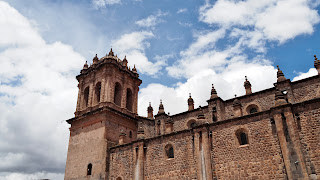We are off on a city tour today…taking in some of the Spanish Colonial portions of the city and some Inca Ruins.
 |
| Inca Wall |
The city was founded by the Killke culture around 1100AD. When the area was conquered by the Inca in the 16th century they made Cusco the capital of the vast Inca empire. They built many temples, administrative building and neighborhoods. You can't walk anywhere without seeing evidence of Inca construction.
Cusco was the capital city of the Inca Empire until the Spanish conquest. It is at 11,200 feet. We are taking our altitude medicine and while neither of us have had altitude sickness we are constantly winded. The air is very thin here. Cusco is a wonderful city...great for long walks, people watching, great dining and incredible history. The only downside is that it is at 11,200 feet above sea level. We can't walk 50 yards before we are huffing and puffing like we've run a marathon. Really annoying. We used to do better at altitude, getting older.
First stop of the day was the Coricancha, now the Convent of
Santo Domingo. Coricancha, The Temple of
Gold, was the most important temple in the Inca Empire and the walls were
covered with gold with a courtyard filled with gold statues. When the Spanish conquistadors they of course
took the gold and then destroyed the temple although some of the adjacent buildings
still remain.
Much of the convent is built on a foundation of Inca stones from the Inca Temple on the site. The Incas used massive stone that were tightly interlocking. These portions of the buildings have withstood many earthquakes while portions built by the Spanish often suffered badly.
There was a huge indoor courtyard with cloisters (many constructed partly from the rooms from the original Inca buildings here).
The complex set on a hill with terracing and gardens, some of which were from the original Inca footprint of the area.
We had good views of the hillsides around Cusco from the top of the terraces.
From there we moved on to the main square of Cusco, the Plaza De Armas or Huacaypata (Warrior’s Plaza of the Incas).
The main stop here was the Cathedral of Cusco…a truly impressive building.
From there we took a drive up into the hillsides where we stopped at the statue of a white Christ overlooking the city.
Views were great.
The massive citadel of Saqsayhuaman (or Saqsaywaman) sits high over the city of Cusco at 12,142 above sea level (over 1,000 feet higher than Cusco). It was built in the early days of the Inca Empire. According to Inca oral history, Pachacuti, considered the greatest of the Incas, called Cusco the Lion City. The two rivers were the tail, the body was the great square and the houses around it...but it needed a head. So this hill high above the city was designated as the head of the lion.
The complex was built with massive stones. Our guide said that the largest was 120 tons. The stones were cut carefully so that they fit together perfectly without mortar and all of the stones were hewn by hand without benefit of iron tools. Most fit so tightly together that you can’t insert a knife or a piece of paper into the seams.
*************************************
More Saqsaywaman
*************************************
Many of the smaller stones were removed by the Spaniards to use as construction materials for buildings in other parts of the city.
We also stopped at another Inca ruin, Qenqo. This one was different from many of our other
Inca ruins site in that most of the site is naturally occurring rock formations.
They believe that the site was where sacrifices and mummification took place.
From there we found a hillside restaurant where the owner allowed us to use her table to have our boxed lunches. The sandwiches were especially good with Peruvian soft cheese, chopped pecans, arugula and thinly sliced apples on a really awesome seed bread. We bought drinks there and left her a nice tip for the use of her table.
We were supposed to see two more Inca sites but with Paul not
particularly well so we decided to end the day.
Back at the hotel we took naps and Mary worked on photos. To bad we don't have more energy. Cusco is a vibrant and interesting city. We need time to explore (and the energy).
































No comments:
Post a Comment